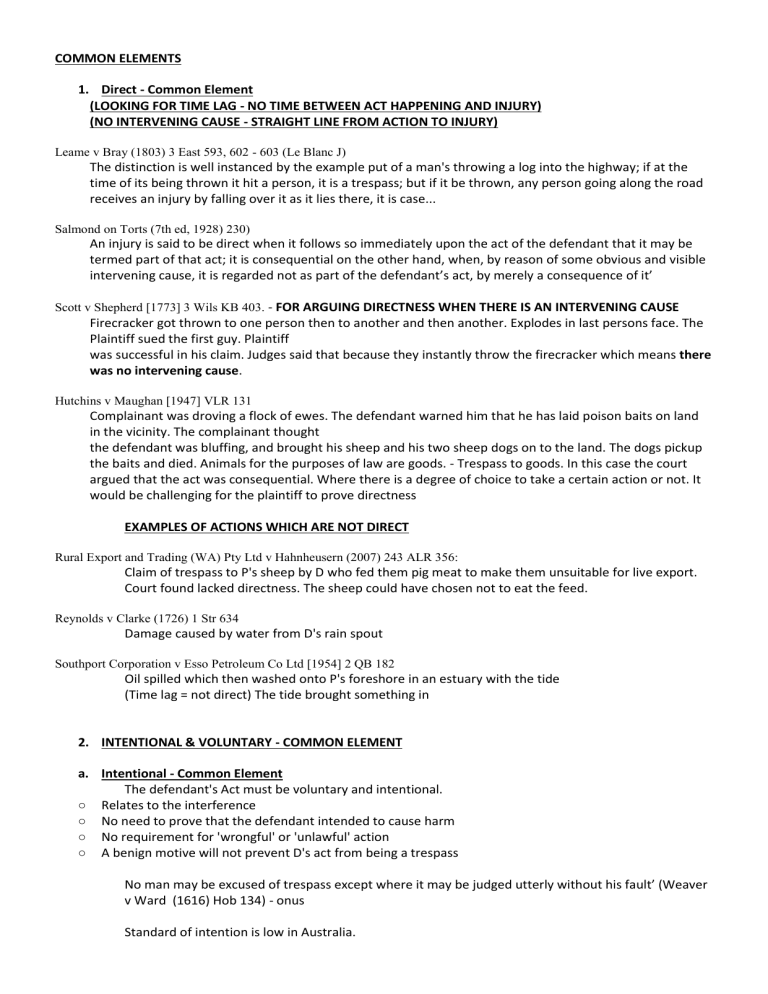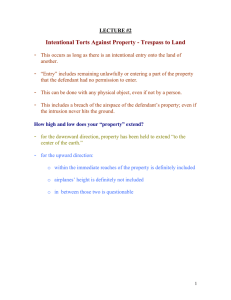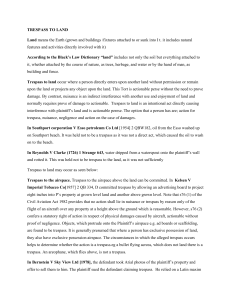
COMMON ELEMENTS 1. Direct - Common Element (LOOKING FOR TIME LAG - NO TIME BETWEEN ACT HAPPENING AND INJURY) (NO INTERVENING CAUSE - STRAIGHT LINE FROM ACTION TO INJURY) Leame v Bray (1803) 3 East 593, 602 - 603 (Le Blanc J) The distinction is well instanced by the example put of a man's throwing a log into the highway; if at the time of its being thrown it hit a person, it is a trespass; but if it be thrown, any person going along the road receives an injury by falling over it as it lies there, it is case... Salmond on Torts (7th ed, 1928) 230) An injury is said to be direct when it follows so immediately upon the act of the defendant that it may be termed part of that act; it is consequential on the other hand, when, by reason of some obvious and visible intervening cause, it is regarded not as part of the defendant’s act, by merely a consequence of it’ Scott v Shepherd [1773] 3 Wils KB 403. - FOR ARGUING DIRECTNESS WHEN THERE IS AN INTERVENING CAUSE Firecracker got thrown to one person then to another and then another. Explodes in last persons face. The Plaintiff sued the first guy. Plaintiff was successful in his claim. Judges said that because they instantly throw the firecracker which means there was no intervening cause. Hutchins v Maughan [1947] VLR 131 Complainant was droving a flock of ewes. The defendant warned him that he has laid poison baits on land in the vicinity. The complainant thought the defendant was bluffing, and brought his sheep and his two sheep dogs on to the land. The dogs pickup the baits and died. Animals for the purposes of law are goods. - Trespass to goods. In this case the court argued that the act was consequential. Where there is a degree of choice to take a certain action or not. It would be challenging for the plaintiff to prove directness EXAMPLES OF ACTIONS WHICH ARE NOT DIRECT Rural Export and Trading (WA) Pty Ltd v Hahnheusern (2007) 243 ALR 356: Claim of trespass to P's sheep by D who fed them pig meat to make them unsuitable for live export. Court found lacked directness. The sheep could have chosen not to eat the feed. Reynolds v Clarke (1726) 1 Str 634 Damage caused by water from D's rain spout Southport Corporation v Esso Petroleum Co Ltd [1954] 2 QB 182 Oil spilled which then washed onto P's foreshore in an estuary with the tide (Time lag = not direct) The tide brought something in 2. INTENTIONAL & VOLUNTARY - COMMON ELEMENT a. Intentional - Common Element The defendant's Act must be voluntary and intentional. o Relates to the interference o No need to prove that the defendant intended to cause harm o No requirement for 'wrongful' or 'unlawful' action o A benign motive will not prevent D's act from being a trespass No man may be excused of trespass except where it may be judged utterly without his fault’ (Weaver v Ward (1616) Hob 134) - onus Standard of intention is low in Australia. How does the law treat direct but unintentional actions? The answer is different in Australia from the United Kingdom. McHale v Watson (1964) 111 CLR 384 Threw a piece of steal, trespass, negligence Croucher v Cachia (2016) 95 NSWLR 117 The evidence suggested that the gardener was holding a pair gardening sheers. Can you demonstrate it is intentional? the court considered the range of authorities when you cannot prove the act is intentional. b. Voluntary - Common Element Gibbons v Pepper: Who strikes the horse is important, not who rides it Morris v Marsden: Where D knew what he was doing but not that it was wrong. Stable J said acts performed in complete automatism or sleep walking not actionable. Knowledge of wrongdoing is immaterial - capacity to know the nature and quality of the act is sufficient, even where the mind directing the hand that did the wrong is 'diseased’. if their arms are moving their hands are moving - it is said to be considered voluntary. As long as you know your mouth is moving that is sufficient See also Fede v Gray - ice addict bit a cop.


